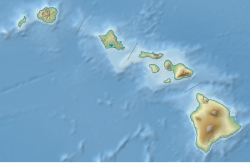1868 Hawaii earthquake
| UTC time | 1868-04-03 02:30 |
|---|---|
| USGS-ANSS | ComCat |
| Local date | April 2, 1868 |
| Local time | 16:00 |
| Magnitude | 7.9 Mfa[1] |
| Epicenter | 19°12′N 155°30′W / 19.2°N 155.5°W |
| Areas affected | Hawaiʻi |
| Total damage | Limited [1] |
| Max. intensity | MMI X (Extreme) [1] |
| Tsunami | Yes |
| Casualties | 77 killed [1][2] |
The 1868 Hawaiʻi earthquake was the largest recorded in the history of
Background
The island of Hawaiʻi (commonly called the "Big Island") is the currently active volcanic center of the
This flank displacement is linked to extension within the rift zones associated with both of the active volcanoes, the Mauna Loa and Kīlauea rifts. From the interpretation of
| Selected Mercalli Intensities | ||
MMI |
Locations | |
|---|---|---|
| MMI X (Extreme) | ||
| MMI VIII (Severe) | Kohala | |
| MMI VII (Very strong) | Kealakekua, Waipiʻo | |
| MMI V (Moderate) | Honolulu, Kauaʻi, Lānaʻi | |
| U.S. Earthquake Intensity Database, National Geophysical Data Center | ||
Hilina Slump
The Hilina Slump is the largest of the active slumps around the Hawaiian islands. The 'backscarp' to the slump is formed by the Hilina extensional fault system, which is known to have moved in both the 1868 event and the 1975 Kalapana earthquake.[7]
Earthquake
A firsthand description of the events was written by Frederick S. Lyman, a goat and sheep rancher at Keaīwa near the epicenter of the events.[8] A sequence of foreshocks began on March 27, with tremors every few minutes. They increased steadily in intensity, including one on March 28 that had an estimated magnitude of 7.1. The sequence continued until 4 p.m. on April 2, when the mainshock occurred.[3] One interpretation of this sequence of events is that they were related to the movement of two separate landslide structures on the south side of the island. The first, triggered by an eruption that began in the upper part of Mauna Loa's southwest rift, involved movement of a block that extended seawards for at least 12 miles (19 km). The tremors over the next four days are regarded as aftershocks of the 7.1 event caused by this movement. The mainshock involved movement of the entire southern flank of Kīlauea on the basal detachment at an estimated depth of 9 kilometers (5.6 mi),[9] and was probably triggered by the earlier event.[3]
The aftershock sequence has continued for over 140 years until the present day. The aftershock frequency fits a modified
Damage

Wooden houses were knocked off their foundations in Keaīwa,
Tsunami
A tsunami was caused by coastal subsidence associated with reactivation of the Hilina Slump, triggered by the earthquake. At Kapapala the land subsided by as much as 2 m and formerly dry land was flooded to a depth of 1.5 m.[10] The tsunami on the Kaʻū and Puna coasts caused major destruction at Honuapo, Keauhou (now Keauhou Landing) and Punaluʻu. The greatest damage was caused at Keauhou, where a wave height of 12–15 m was reported. All houses and warehouses were destroyed and 46 people were drowned.[10]
Many villages, such as ʻĀpua, were never resettled.[11]
Landslides
The earthquake triggered landslides over a wide area. The largest was a mudslide 3 km wide and 9 m thick, that swept down the flanks of Mauna Loa at Kapapala. It swept away trees, animals and people, causing 31 fatalities.[10]
Effect on volcanic eruptions

Kīlauea was the most affected by the lateral displacement associated with the earthquake, as it did not have another major eruption until 1919.[3] It also disrupted the magma system beneath Mauna Loa, as is shown both in reduced lava volumes and an abrupt change in the lava chemistry.[12]
See also
- List of earthquakes in Hawaii
- List of earthquakes in the United States
- List of historical earthquakes
- List of historical tsunamis
- Category:Articles on pre-1900 earthquakes
References
- ^ doi:10.7289/V5TD9V7K
- United States Government Printing Office, p. 207
- ^ a b c d e "The Great Ka'u Earthquake of 1868". Hawaiian Volcano Observatory. April 1, 1994. Archived from the original on June 29, 2016. Retrieved December 11, 2010.
- ^ .
- ^ Bryan, C.J.; Johnson C.E. (1991). "Block tectonics of the island of Hawaii from a focal mechanism analysis of basal slip". Bulletin of the Seismological Society of America. 81 (2). Seismological Society of America: 491–507. Archived from the original on 2011-09-30. Retrieved 2009-11-12.
- .
- . Retrieved 2009-11-12.
- S2CID 130168932. Retrieved December 11, 2010.
- doi:10.1785/BSSA0780041450. Archived from the originalon 2008-09-05. Retrieved 2009-11-12.
- ^ a b c d e USGS. "Ka'u District, Island of Hawaii 1868 04 03 02:25 UTC (04/02/1868 local) Magnitude 7.9, Largest Earthquake in Hawaii". Archived from the original on 2016-11-10. Retrieved 2009-11-11.
- University of Hawaii Press. Retrieved December 11, 2010.
- S2CID 37524089. Retrieved 2009-11-11.


